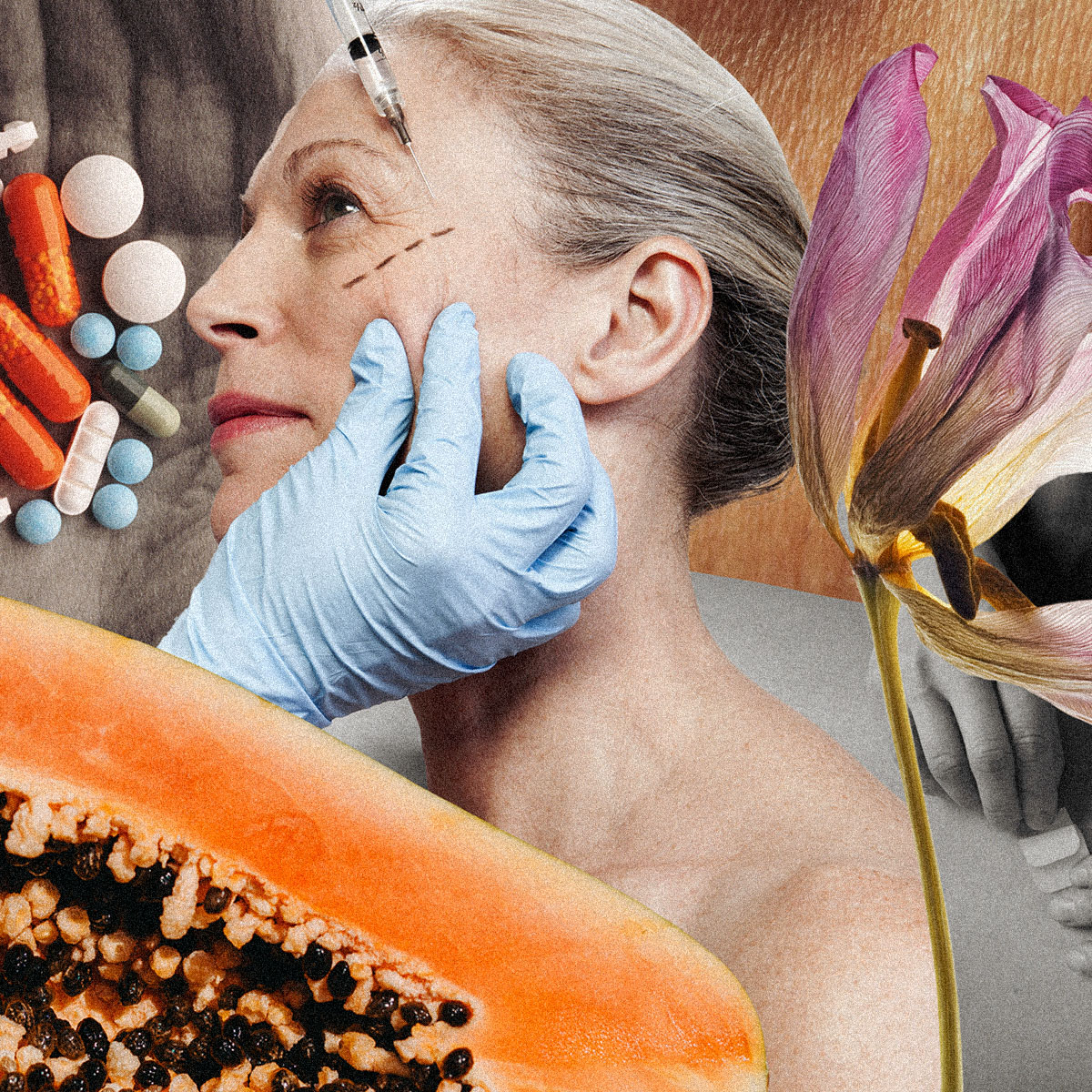
On paper, Lori Smith has passed her biological prime. She’s no longer in her peak physical, sexual, or cognitive age bracket, all of which scientists have identified as falling somewhere between the 20s and 30s. She’s in her 40s—48, to be exact. Her hot flashes are in high gear, her sex drive is on a downward trajectory, and when she looks in the mirror, she thinks, time for Botox. But Smith says she’s cracked the code to feeling “a hundred times better.”
She is part of a growing cohort of women taking "menopause makeovers"—a term coined to describe refinement and rejuvenation of the mind, body, and overall health—mainstream. With a well-trained team of endocrinologists, gynecologists, plastic surgeons, and dermatologists, growing older doesn't have to mean feeling old.
“There’s this outdated idea that aging means becoming less vibrant. More than ever, people in their 50s, 60s, and beyond are prioritizing wellness, investing in self-care, and seeing aging as a time of reinvention rather than decline,” says board-certified plastic surgeon and co-founder of Inside Beauty Spa Sheila Malek Kassir, MD. “But it’s not just about aesthetics; it’s about aligning how you look with how you feel: strong, confident, and full of life.”
Flipping the script on what it means to be in menopause has been a long time coming. Turning 50 no longer means it’s time for a Golden Girls-style haircut or to start a Tupperware Club, especially since markers for Big Life Events are increasingly pushed back. More than 100,000 Americans now give birth in their 40s. One in 10 workers in the U.S. are over 55 and the average retirement age is 65. Life doesn't stop after 30—in fact, it tends to only get busier with age. In 2025, hitting menopause, which typically occurs between 45 and 58, [Black and Asian women are shown to experience the onset of symptoms earlier than White women], signals the need for a new toolkit to stay active, feel hot, and look refreshed.
It’s about aligning how you look with how you feel: strong, confident, and full of life.
Dr. Sheila Malek Kassir
What's Involved in a Menopause Makeover?
Pushing back against our natural biological clock wouldn’t be possible without aesthetic advancements since, like it or not, there are distinct physiological changes that happen during this period in a woman's life. “From a clinical perspective, estrogen decline leads to approximately 30 percent collagen loss within the first five years of menopause, resulting in increased skin laxity, volume depletion, and textural changes,” explains board-certified dermatologist Pooja Rahmbia, MD. The dip in estrogen, which is said to drop 90 percent throughout menopause and level out in post-menopause, can also leads to “fat loss, particularly in the mid and upper face, and fat gain in the torso, breasts, and other areas of the body,” says board-certified plastic surgeon Adam Kolker, MD.
For the women spearheading the menopause makeover movement, addressing these changes to their appearance isn’t about jumping in a time machine. It’s about feeling and looking like they’re capable of doing everything they already are, like running a Fortune 500 company or being an active mother or grandmother. “They’re not trying to look 20; they just want to look as energized and youthful as they feel,” says Dr. Kassir.
Achieving the most comprehensive outcome often requires a multi-step, multi-targeted approach that combines skincare, aesthetics, and plastic surgery. In addition to topical care—retinoids, peptides, and a great foundation for mature skin—many women are opting for injectables, innovative lasers, and more invasive skin rejuvenating procedures allow many menopause makeover patients to maximize results and minimize downtime. This new era of procedures takes a more comprehensive approach to rejuvenation, prioritizing the condition and health of the skin as a whole—a stark contrast from the one-and-done facelifts of the past. Here, top dermatologists and plastic surgeons share what they're doing (and seeing) the most in their practices.
Injectables and Lasers
It doesn't matter how much retinol you use or the number of lifting serums in your routine; the body's natural production of collagen (the skin's youth factor), elastin (the bounce back factor), and hyaluronic acid (hydration) decreases with age. "This means that there is less protein support, resulting in more noticeable sagging, folds and fine lines, especially in areas where skin is thinner (eyes, neck, décolleté) and where there was frequent movement (neck, peri-oral region, peri-orbital region, and jawline)," explains board-certified dermatologist Dendy Engelman, M.D.. "Women at this stage of life also tend to experience very dry skin as a result of reduced moisture retention."
- Injectables
Dr. Engelman has found success pairing the just-FDA approved Nefertiti Lift—a Botox technique that smooths the neck and defines the jawline—with SkinVive, a first-of-its-kind hyaluronic acid injection for skin smoothness and hydration that hit the US market in late 2023. “We inject Botox into the platysma muscles (a thin muscle that lies along the neck) to smooth and accentuate the neck and jaw, which tend to sag and show signs of crepiness as we age,” Engelman shares. The SkinVive, on the other hand, offers a six-month solution to the skin dryness and rough texture that coincides with menopause.
- Skin Tightening Devices
Board-certified dermatologist Pooja Rambhia, M.D., is a big proponent of combining ultrasound therapy, like Ulthera, with biostimulatory filler to both tighten and plump the skin in an effort to compensate for increased laxity and dwindling volume. “Studies have shown that they have synergistic effects when combined,” she says, leaving patients with more collagen production and skin-tightening results than when either treatment is used individually.
Cosmetic Surgery
Non-invasive treatments are only part of the puzzle when it comes to lifting, firming, and rejuvenating your overall appearance during menopause. Sometimes, a heavier-duty procedure or surgery is necessary to get the desired result. Plastic surgeons' offices are busier than ever, with the American Society of Plastic Surgeons reporting that 30 percent of practitioners have seen their businesses more than double since 2021. Of that percentage, women aged 40 to 69 comprise 63 percent of liposuction patients, 52 percent of breast reduction patients, and 81 percent of blepherophasty (upper eye lift) patients.
- Blepheroplasty
Dr. Kolker says a bleph can make the biggest difference in peri-menopausal or menopausal patients. “Due to volume loss and loss of elasticity, the skin of upper and lower eyelids may appear excessive,” he explains. A bleph, in which the surgeon cuts into the crease of the eyelid to remove excess skin, can open the eyes and create a more youthful, wide-eyed appearance.
- Fat Restoration
“Fat restoration, particularly in the tear trough area, also helps smooth the transition between eyelid and cheek, especially when done with complementing eyelid surgery.” Fat grafting is also commonly done in the cheek area. Depending on the patient, this can also coincide with a mini-facelift, which is more frequently being done on younger and younger patients.
Hormonal Therapy
Perhaps the most crucial component to the menopause makeover, however, is imperceptible to the naked eye—addressing how the body functions. Enter: hormone therapy, a treatment that seeks to balance shifting hormone levels following the steep decline that coincides with menopause by supplementing levels of estrogen and/or testosterone and progesterone via patches, tablets, gels, or pellets. (Hormone therapy should not be done without warning. Not everyone is a candidate; it is understudied, training among physicians is not standardized, and, according to some doctors, it can lead to increased risk of heart disease, blood clot, stroke, or cancer.)
That being said, board-certified OB/GYN and founder of HerMD Somi Javaid, MD, along with dozens of leading practitioners in the field, note that the benefits of hormone therapy, which is most commonly administered systemically or locally, are transformative. “Because women have estrogen receptors from head to toe, we are learning that symptoms are hot flashes, brain fog, frozen shoulder, weight gain, joint pain, low libido, insomnia—almost all of them can be mitigated with hormone therapy,” explains Dr. Javaid. “The beautiful thing is that it treats the visible and invisible symptoms. Hormone therapy can help with muscle mass and energy…it can help with bone density and cognition, too.”
That’s the goal of a menopause makeover. Not to nip-tuck women into looking a decade younger, but to give them the tools (and a few tweakments) to feel like the sexiest, healthiest, most empowered version of themselves, no matter their age. “It’s made everything easier; I felt vibrant and alive again,” Smith says, who has been doing a mix of hormone therapy, Botox, and lasers for the past two years. She’s living proof that women in their 50s (and 60s and 70s and 80s) are still very much in their prime.







